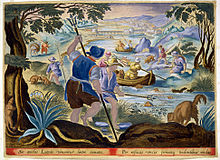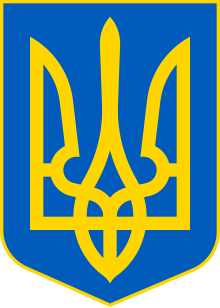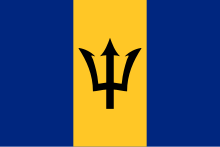- Large, Adult Sized, 4 Foot Long overall
- Hand forged by a black smith
- Antique - light cosmetic rusting
- TRIDENT!!
- Tong area is 10" T x 9" W
- Rare, Hard to find!
- See sizing relative to the soda can in the pics.
- I ship out daily!
Trident

A trident (/ˈtraɪdənt/) is a three-pronged spear. It is used for spear fishing and historically as a polearm.
The trident is the tool of Poseidon (Greek) or Neptune (Roman) used for the protection of the sea realms, the god of the sea in classical mythology. Other sea deities such as Amphitrite or Triton were also often depicted with a trident in classical art. Later, tridents were used in medieval heraldry, sometimes held by a merman or triton. In Hinduism, it is the weapon of Shiva and is known as a trishula (Sanskrit for "triple-spear").
Etymology[edit]

The word "trident" comes from the Latin word tridens or tridentis: tri meaning "three" and dentes meaning "teeth", referring specifically to the three prongs, or "teeth", of the weapon.[1]
The Greek equivalent is τρίαινα (tríaina), from Proto-Greek trianja, meaning "threefold". The Greek term does not imply three of anything specific, and is vague about the shape, thus the assumption it was originally of "trident" form has been challenged.[1]
Latin fuscina also means "trident".[2]
The Sanskrit name for the trident, trishula, is a compound of tri त्रि for "three" and śūla शूल for "thorn", calling the trident's three prongs "thorns" rather than "teeth" or dant in Sanskrit, making the word "Tridant" for trident.[citation needed]
Mythology and art[edit]

Poseidon[edit]
The trident is associated with the sea god Poseidon. This divine instrument is said to have been forged by the cyclopes.[3]
Poseidon struck a rock with his trident, causing a sea (or a saltwater spring, called the Erechtheis) to appear nearby on the Acropolis in Athens.[4][5] And according to Roman sources, Neptune struck the earth with the trident to produce the first warhorse.[6]
Poseidon, as well as being the god of the sea, was also known as the "Earth Shaker",[7] believed to cause earthquakes;[8][a] some commentators[who?] have extrapolated that the god would have used the trident to cause them,[9] possibly by striking the earth.[citation needed]
In the Renaissance artist Gian Bernini's sculpture Neptune and Triton (1622–23), Neptune is posed holding a trident turned downwards, and is thought to reenact a scene from Aeneid or Ovid's Metamorphoses where he is calming the waves to aid Aeneas's ships.[10]
Other sea divinities[edit]
In later Greek and Roman art and literature, other sea deities and their attendants have been depicted holding the trident.
Poseidon's consort Amphitrite is often identified by some marine attribute other than a trident, which she never carries according to some scholars, though other commentators have disagreed.[11][13]
Turning to the retinue or a train of beings which follow the sea deities (the marine thiasos) the Tritons (mermen) may be seen bearing tridents.[14] Likewise, the Old Man of the Sea (halios geron) and the god Nereus are seen holding tridents.[14] Tritons, other mermen, and the Nereides can also carry rudders, oars, fish, or dolphins.[14]
Oceanus normally should not carry a trident, allowing him to be clearly distinguished from Poseidon. However, there is conflation of the deities in Romano-British iconography, and examples exist where the crab-claw headed Oceanus also bears a trident.[16][17] Oceanus holding a trident has been found on Romano-British coinage as well.[b][18]
Some amorini have been depicted carrying tiny tridents.[c][19]
The trident is even seen suspended like a pendant on a dolphin in Roman mosaic art.[d][20]
Hindu Religion[edit]
In Hindu legends and stories Shiva, the Hindu god uses a trishula as his principal weapon. The trident is also said to represent three gunas mentioned in Indian Vedic philosophy namely sāttvika, rājasika, and tāmasika.[citation needed] The goddess Kali is sometimes portrayed with a trident as well.[21]
A weapon of South-East Asian (particularly Thai) depiction of Hanuman, a character of Ramayana.[citation needed]
Miscellaneous[edit]
In religious Taoism, the trident represents the Taoist Trinity, the Three Pure Ones. In Taoist rituals, a trident bell is used to invite the presence of deities and summon spirits, as the trident signifies the highest authority of Heaven.[citation needed]
A fork Jewish priests (Kohanim) used to take their portions of offerings.[22]

In heraldry within the UK, the trident is often held by the figure identified as either a Neptune or a triton,[e][23][24] or a merman.[f][25]
The trident held up by an arm is depicted on some coats-of-arms.[26]
Use[edit]

Fishing[edit]
In Ancient Greece, the trident was employed as a harpoon for spearing large fish, especially tuna fishing.[27]
Tridents used in modern spear-fishing usually have barbed tines, which trap the speared fish firmly. In the Southern and Midwestern United States, gigging is used for harvesting suckers, bullfrogs, flounder and many species of rough fish.[28]
Agriculture[edit]
It has been used by farmers as a decorticator to remove leaves, seeds and buds from the stalks of plants such as flax and hemp.[citation needed] A form of trident is used by the gardians in the Camargue of southern France for herding cattle.[citation needed]
Combat[edit]
In Ancient Rome tridents (Latin: tridens or fuscina) were used by a type of gladiator called a retiarius or "net fighter". The retiarius was traditionally pitted against a secutor, and cast a net to wrap his adversary and then used the trident to fight him.[29][30]
Tridents were also used in medieval heraldry.
The trident, known as dangpa, is used as a weapon in the 17th- to 18th-century systems of Korean martial arts.[citation needed]
Modern symbolism[edit]
This section needs additional citations for verification. (February 2021) |
The glyph or sigil of the planet Neptune (♆), which alludes to the trident, is used in astronomy and astrology.
Political[edit]


- The Tryzub in the Coat of Arms of Ukraine, adopted in 1918 (in a reinterpretation of a medieval emblem which is traced to the Volodymyr the Great, but may likely depicted a Algiz (also Elhaz) Viking rune that was introduced by Olga of Kyiv).
- The national and presidential flags of Barbados.
- The "forks of the people's anger", adopted by the Russian anti-Soviet revolutionary organization, National Alliance of Russian Solidarists (NTS).
- Britannia, the personification of Great Britain usually depicted to hold a trident.
Civilian use[edit]
- The symbol for Washington and Lee University.
- King Triton, the mascot of the University of California, San Diego, holds a trident, and the trident is omnipresent in UCSD’s athletic gear.
- The symbol (since June 2008) for the athletic teams (Tritons) at the University of Missouri–St. Louis.
- Sparky the Sun Devil, the mascot of Arizona State University, holds a trident. (ASU recently[when?] redesigned its trident as a stand-alone symbol.)
- The trident was used as the original cap insignia and original logo for the Seattle Mariners. Although the Mariners changed their cap insignia & logo away from a trident theme in 1993, the club allows players to use a trident as a prop after hitting home runs during games. The trident prop used by the team is a replica from the 2018 film Aquaman.[31]
- An element on the flag of the Sea Shepherd Conservation Society.
- The Maserati logo.
- Club Méditerranée.
- The Hawker Siddeley Trident, a 1960s British three-engine jet airliner.
- The Tirreno–Adriatico cycle race trophy.
- The exterior of the World Trade Center used three-pronged decorative and structural elements at its base, commonly referred to as "tridents".
Military insignia[edit]

- The emblem of the Hellenic Navy
- The emblem of the Cyprus Navy
- The insignia of Nepal Army
- With Poseidon in the 31st Brigade.
- The symbol of the Swedish Coastal Rangers, Kustjägarna.
- The trident is a recurring element in the colours of certain units of the Finnish navy.
- The United States Naval Special Warfare Command, and the Special Warfare insignia, particularly worn by members of the US Navy SEALs, and containing a trident representing the three aspects (Sea, Air, and Land) of SEAL special operations.
- Part of the golden-colored crest of the United States Naval Academy, which depicts a trident running vertically in its background.
- The ship's crests of 13 of the 18 Ohio-class submarines of the U.S. Navy prominently feature tridents, as both a symbol of maritime power, and in reference to their payloads of Trident D-5 missiles.
- The rating badge of the United States Coast Guard Marine Science Technician.
- The Tug Banner used by Mongolian Honor guards.
- The insignia of the German commando force, Kampfschwimmer.
- The rating badge of the United States Navy Ocean Systems Technician (OT)
Botanical nomenclature[edit]
A number of structures in the biological world are described as trident in appearance. Since at least the late 19th century the trident shape was applied to certain botanical shapes; for example, certain orchid flora were described as having trident-tipped lips in early botanical works.[32] Furthermore, in current botanical literature, certain bracts are stated to have a trident-shape (e.g. Douglas-fir).[33]
Gallery[edit]
Merfolk
Merfolks, Mercreatures, Mermen or Merpeople are legendary water-dwelling human-like beings. They are attested in folklore and mythology throughout the ages in various parts of the world.
Female merfolks are called mermaids, although in a strict sense mermaids are confined to beings who are half-woman and half-fish in appearance. Male merfolks are called mermen. Depending on the story, they can be described as either ugly or beautiful.
Chinese renyu (人魚) stands for "merfolks", but in ancient geographical or natural historical tracts, this referred to "human-fish" or "man-fish" purported to inhabit rivers or lakes in certain parts of China. Japanese ningyo (人魚) is also "merfolks" and also applied to various human-like fish recorded in writings from medieval times into the Edo Period.
China[edit]
Certain fantastical types of "fish", generically referred to as renyu (人魚, "human-fish") is alleged to occur in various parts of China according to the Shan Hai Jing (Classic of Mountains and Seas, 4th century BC). It is mentioned in the Bei Shan Jing ("Classic of the Northern mountains"), Zhong Shan Jing (Central Mountains), and Xi Shan Jing (Western Mountains) sections of this work.[1][2]
This work and others also mention several additional types of "anthropomorphic fish"[3] with limbs in other regions such as the chiru (赤鱬; "red ru fish"[4]) and lingyu (陵魚; "hill-fish"), considered to be in the same category of creatures. Certain tribes or races of humans were also described being part-fish, namely the Di people.[5][1]
It is recorded that the Mausoleum of the First Qin Emperor was illuminated with lamps fueled by the oil of the human-fish (renyu), whose flames were meant to last a very long time.[6][7]
Renyu or human-fish[edit]
- (aka haieryu. subtypes tiyu and niyu )
The renyu (人魚; human-fish) is described in the Bei Shan Jing ("Classic of the North Mountains") section as dwelling on Mt. Longhou (龍侯山, "Dragon-Marquis Mountain") in the waters of the Jueshui (決水, "Bursting River"), which flows eastward into the Yellow River.[11] It is said to "resemble the tiyu"[12][13] (translated as "resemble catfish"[14][10][15])[16][c][20] possess four legs, with a voice like baby crying.[21]
Eating the fish purportedly cured idiocy[14] or dementia.[22][23] This fish as a cure was also quoted in the Compendium of Materia Medica or Bencao Gangmu (1596) under its entry for Tiyu (Chinese: 䱱魚) [21]
The Bencao Gangmu categorized the tiyu (䱱魚) as one of two types of "human-fish" (renyu). The human-fish were also known as "child-fish" or haieryu (孩兒魚; 孩儿鱼).[21][29]
The other type, called the niyu (鯢魚) is elaborated in a separate section.[32] It has been noted by Li Shizhen that the character for the Niyu (Ni 鯢 fish) consists of the "fish" indexing component (魚) and "child" (兒) radical.[31]
Translators of the Bencao Gangmu attempt to match entries with actual taxa of animals, forbs, etc., where possible, and the tiyu type is glossed as "newts" while the niyu type is "Chinese giant salamander".[26]
Chiru or red ru fish[edit]

The chiru (赤鱬; "red ru fish".[4] Wade-Giles: ch'ih-ju; "red ju"[34]) is described in the Nan Shan Jing ("Classic of the Southern Mountains") as a human-headed fish. It is said to be found in the Qingqushan (青丘山 "Green-Hills Mountains") in the Pool-of-Yi (Yì zhī zé 翼之澤; "Carp-Wings Lake"). It is described as basically fish-form but having a human face, and issuing sounds like the mandarin duck. Eating it purportedly prevented scabies or itchy skin.[35][4]
The illustration of the chiru from China may have influenced the legless, human-faced fish visualization of some of the ningyo in Japan, according to the hypothesis of Morihiko Fujisawa.[36]
Jiaoren[edit]
The jiaoren (蛟人 "flood dragon people" or 鮫人 "shark people")[38][e] that appear in medieval writings are considered to be references to merfolk.[3][40][41]
This mythical southern mermaid or merman is recorded in Ren Fang's Shuyi ji "Records of Strange Things" (early 6th century CE).[43][44]
Similar passages appear in other texts such as the Bowuzhi (博物志, "Treatise of Manifold " c. 290 CE) as "weep[ing] tears that became pearls".[47][48][49][f]
These aquatic people supposedly spun a type of raw silk called jiaoxiao 蛟綃 "mermaid silk" or jiaonujuan 蛟女絹 "mermaid woman's silk". Schafer equates this with sea silk, the rare fabric woven from byssus filaments produced by Pinna "pen shell" mollusks.[50][g]
Japan[edit]
The ningyo (人魚 "human-fish") of Japan has its own history in the country's literary record. The earliest references (in the Nihon shoki, entry for year 619, reign of Empress Suiko) do not specifically use the term ningyo, and the "thing" appeared in fresh water (a river in Ōmi Province, canal Settsu Province), and may presumed to be a giant salamander.[52] Later accounts claim that Empress Suiko's regent Prince Shōtoku knew the creature to be a ningyo when one was presented to him by representatives of Ōmi. [53] The appearance of the human-fish was strongly associated with ill omen in later treatments of the Prince's encounter with the human-fish.[54]
During the Kamakura Period, ningyo of the marine sort were frequently reported as washing ashore, and these were taken to be ominous signs usually prefiguring bloody battles.[55]
The ningyo, or rather renyu (人魚) and the like found in Chinese sources (chiru, tiyu etc., etc., discussed above) were also discussed in Japanese literature, for example, works of scholars of herbal and traditional medicine, such as Kaibara Ekiken (d. 1714) and Ono Ranzan (d. 1810). These Japanese scholars were also aware of European discussions on "sirens", "anthropomorphic fish", "peixe muller (fish-woman)", etc.[56][57]
In popular culture[edit]
- Merfolks are a fictional race of humanoids that live underwater in Dungeons & Dragons.
- Merfolks are humanoid aquatic creatures with fish-like characteristics in Magic: The Gathering.
- Merfolks are humanoid aquatic creatures with fish-like characteristics in Spectromancer.
- In One Piece, the Merfolk are among the different races in the anime and one of the two types that dwell underwater (the other being the Fishmen). Each of the Merfolk has their "fish" parts based on different fishes and related creatures like coelacanths, icefish, kissing gouramis, Japanese rice fish, striped beakfish, righteye flounders, olive flounders, blue-striped angelfish, smelt-whitings, sharks, oarfish, opahs, blue-ringed octopuses, shortfin mako sharks, seahorses, catfish, Bering wolffish, goldfish, and brotulas.



![Tridents (trishula) brought as offerings to Guna Devi, near Dharamsala, Himachal Pradesh, India[34]](https://upload.wikimedia.org/wikipedia/commons/thumb/9/94/Tridents_%28Trishul%29_brought_as_offerings_to_Guna_Devi.%2C_near_Dharamsala%2C_Himachal_Pradesh.jpg/90px-Tridents_%28Trishul%29_brought_as_offerings_to_Guna_Devi.%2C_near_Dharamsala%2C_Himachal_Pradesh.jpg)


